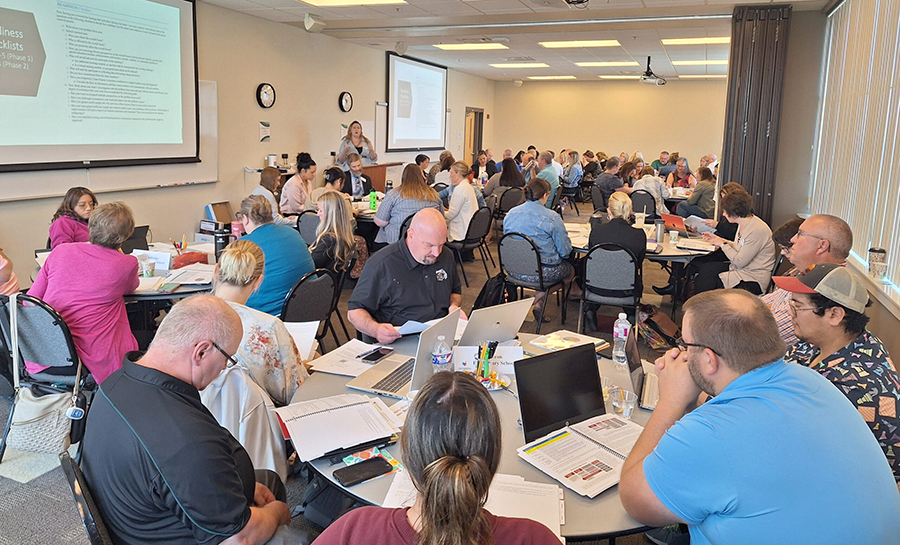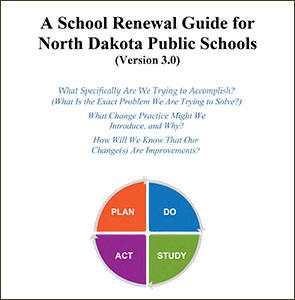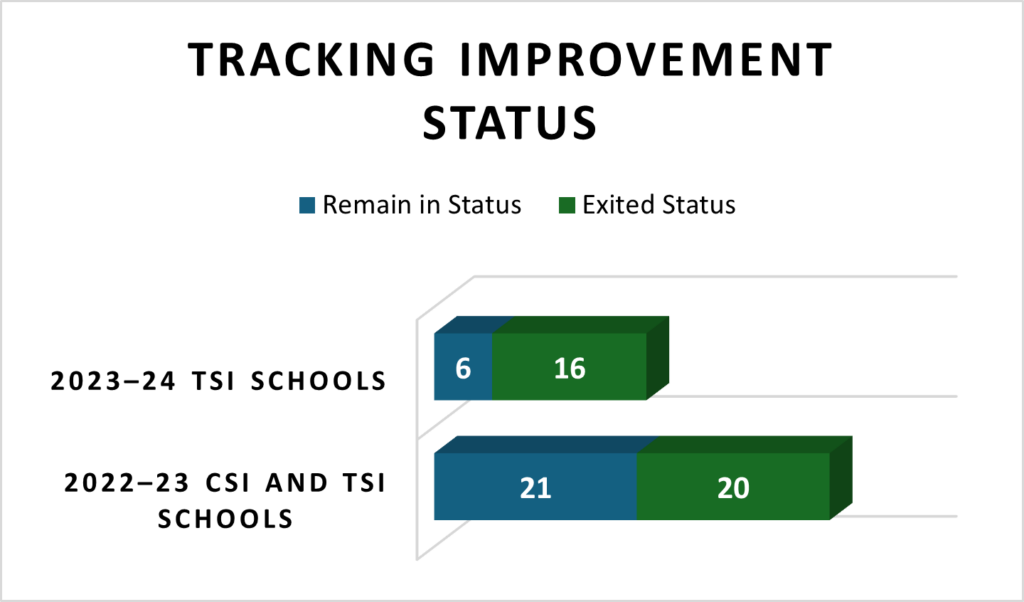When the Every Student Succeeds Act (ESSA) began requiring states to identify schools for support and improvement plans, the North Dakota Department of Public Instruction (NDDPI) recognized a statewide challenge. As a variety of improvement efforts got underway at individual schools and districts, the department lacked an overarching plan and uniform framework to set statewide expectations and monitor if the work was resulting in real change.
The NDDPI Office of Educational Improvement and Support reached out to the Region 11 Comprehensive Center (R11CC) to help solve this high-leverage problem of how to support and monitor continuous improvement in Targeted Support and Improvement (TSI) and Comprehensive Support and Improvement (CSI) schools and districts using evidence-based practices.

CSI school improvement teams meeting with Rachel Tabler from NDDPI to review the School Renewal Guide’s latest updates.
“Working with Region 11, we wanted to do a deeper dive into what our schools truly need,” said Rachel Tabler, assistant director with the Office of Educational Improvement and Support. “We wanted to do some root cause analysis of why some schools reappear on this list.
Do we need to be engaging with them differently? Do we need a different process in order to help them exit from either TSI or CSI?”
The team agreed that anything they created needed to become embedded into the fabric of their systems and processes, scaled statewide to all TSI/CSI schools, and touch every aspect of the state’s K–12 school ecosystem. To achieve this, they set out to empower school teams to do their own problem solving.
“For many years leading up to this work, schools were conditioned to have outside vendor groups come in and basically do improvement to them versus improvement alongside them,” said Ben Cronkright, R11CC’s co-lead for North Dakota. “So from the beginning we wanted to create a model that would support and build the capacity of school teams to lead their improvement efforts.”
A Capacity Building, School-Level Approach for Sustainable Improvement
NDDPI and the R11CC began by building out the partnership. Teams from several schools and districts were brought into the work as early adopters. Next, leveraging existing relationships and partnerships, the North Dakota University System was invited to join the effort by supporting data collection and data use. With the university system’s expertise, the state’s capacity for, clarity of, and transparency with data collection, analysis, and literacy was greatly expanded. With their support, improvement schools and districts were better able to understand the identification formulas and have useful tools to interpret their data.
About a year into the work, the partnership realized they needed more boots on the ground, something the state’s education service agencies could provide. “They’re regionally located and close to the schools,” said Tabler. “They know the communities, and many of them already work in those schools.”
The North Dakota Regional Education Association (NDREA) supports seven education service agencies across the state. Within the R11CC partnership, NDREA’s leaders and regional coaching liaisons operationalized and scaled the work to bring it directly into every TSI/CSI school through coaching on the improvement science framework and use of evidence-based practices.
Once NDREA joined the partnership, “we really had alignment across all parts of the K–12 education system that set it up to do what it was intended to do—to support each school team with implementing their change and improvements well,” said Cronkright.
Structures: Collaborative Teams and a Common Framework for Improvement
While each entity plays its own role within the partnership, representatives also participate in three collaborative cross-agency teams that guide the work:
- The guidance team selected the Carnegie Foundation’s Continuous Improvement Framework as the school improvement theory of action for approaching all TSI/CSI work.
- The implementation team, through working strategy sessions, identifies the technical assistance plans, which are important for developing and maintaining project timelines.
- The core team focuses on facilitation and continuous improvement, helping define the project’s direction and then stopping periodically to evaluate and assess if they’re meeting their goals.

North Dakota’s accountability system provides a framework to holistically evaluate the ability of ND education system to achieve desired student outcomes.
Supporting and Sustaining Continuous School Improvement
From these meetings and technical assistance work came one of the largest outputs to date, the creation of the North Dakota School Renewal Guide. Now in its third edition, the guide distills the methodology of school improvement science and outlines three phases for all TSI/CSI school renewal teams to follow to identify the problem they’re trying to solve, consider the change practices they can introduce, and create measurements to check if the practice is resulting in desired changes.
“R11CC helped us create a resource that we’re really proud of,” said Amanda Peterson, director of the Office of Educational Improvement and Support. “It’s an actual tool that school improvement teams can use. Region 11 supported us with the heavy lifting of putting it together, but NDDPI was able to inform the adjustments and revisions that we knew would be relevant to our state and our work. We personalized it, yet still held true to the improvement science approach.”
In tandem with creating the guide, the R11CC began training all the partners and teams who would promote its use statewide. This technical assistance produced multiple pathways for understanding and using improvement science tools and methods, including professional learning across the agencies and teams, as well as the creation of a short video on the plan-do-study-act (PDSA) cycle of improvement science. The R11CC worked closely with regional agency leadership and coaching liaisons to ensure they understood the framework and the state’s expectations.
The R11CC team also promoted the use of communities of practice to ensure trainings weren’t simply delivered once and then forgotten. “The whole idea is to build on each technical assistance activity, so it isn’t a one-and-done thing,” said Cronkright.
Measuring Progress and Moving Forward
As the current R11CC project is in its fifth and final year, the partnership work is focused on efforts to ensure long-term sustainability. “Our R11CC goal from the onset has been to build local capacity and essentially work ourselves out of the work,” said Cronkright.
The partnership is focusing on how to best support the regional education agency liaisons as well as ensure calibration and data transparency and continue to build trusting, supporting relationships across the partnering agencies and schools. One current task is reducing variability in how schools measure short-cycle improvement and ensuring that the body of collected evidence is consistent and accurate across the state. Within the guidebook, the NDDPI team created a rubric/progress scale, which helps track each school team’s progress on their improvement project, so the data isn’t just reflective of interim assessment data, but also tracks the school’s ability to implement something well, said Cronkright.
In addition to understanding their data, the rubrics will contribute to a more thorough body of evidence for schools to exit TSI/CSI status. Peterson explained that even if one year’s worth of work isn’t quite enough to get a school out of status, the collected evidence will help the school see that they’re heading in the right direction.
“I really like where we are with our schools. We know more about what the schools are doing than we’ve ever known,” said Tabler. Between the improvement office staff and the regional liaisons, crucial conversations happen regularly and there is a clearer understanding of the work being done and the requests being made, and there is respect among the team for each other as they’re all working toward the same goal, she said.
Recognizing Positive Results
Some schools using this approach have exited TSI/CSI status during the course of the partnership, as shown in the Tracking Improvement Status table.
One example of an exiting district in 2022–23 was Parshall School District, which is located on the Fort Berthold Indian Reservation. When they began creating a school renewal plan, the district identified the long-standing problem of lagging student attendance as a focus for its efforts and collaborated to generate a fishbone diagram to understand what systemic factors contributed to the attendance problem. School leaders noted that they had not previously worked intentionally with attendance data, nor built awareness for parents and others about what the data reported.
Sharing the tracked data with parents and the community helped increase awareness of how important attendance is to student academic outcomes and led to changes across the community that included work with members of the Tribal Council. This united approach addressing a community-wide problem helped eliminate operational silos that could have hampered success. The district also made changes to administrative practices, including relieving teachers of some of the attendance tracking responsibilities by creating an attendance coordinator position. The schools also revised how they count absences. These changes made a solid improvement in attendance from fall to spring in the 2022–23 school year, increasing regular attendance by 18 percentage points and decreasing the chronic absence rate by 5.6 percentage points.
In addition to individual school turnaround examples, the partnership members also point to the state model itself as another success story. “It’s a combination of a lot of things, but the creation and use of the state guidebook coupled with the regional coaching is promoting systems change that obviously impacts the schools’ abilities to improve outcomes for their students,” Cronkright said.
The model sets up a process that can be repeated year in and year out, starting the moment a school is identified and continuing all the way to when the school exits status. Each district and school is responsible for its own work, but the whole collective body pulling together is a major component of its success, Simpson said. “This partnership has created a prototype that other states can now use to support their CSI and TSI districts and schools,” said Simpson.
Contact
For more information about the work being done in North Dakota, please contact R11CC co-directors Joe Simpson and Susan Shebby.
Want to share this story with others? Download a PDF version here.
